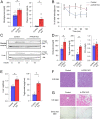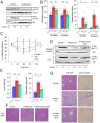The PDK1-FoxO1 signaling in adipocytes controls systemic insulin sensitivity through the 5-lipoxygenase-leukotriene B4 axis
- PMID: 32393635
- PMCID: PMC7261087
- DOI: 10.1073/pnas.1921015117
The PDK1-FoxO1 signaling in adipocytes controls systemic insulin sensitivity through the 5-lipoxygenase-leukotriene B4 axis
Abstract
Although adipocytes are major targets of insulin, the influence of impaired insulin action in adipocytes on metabolic homeostasis remains unclear. We here show that adipocyte-specific PDK1 (3'-phosphoinositide-dependent kinase 1)-deficient (A-PDK1KO) mice manifest impaired metabolic actions of insulin in adipose tissue and reduction of adipose tissue mass. A-PDK1KO mice developed insulin resistance, glucose intolerance, and hepatic steatosis, and this phenotype was suppressed by additional ablation of FoxO1 specifically in adipocytes (A-PDK1/FoxO1KO mice) without an effect on adipose tissue mass. Neither circulating levels of adiponectin and leptin nor inflammatory markers in adipose tissue differed between A-PDK1KO and A-PDK1/FoxO1KO mice. Lipidomics and microarray analyses revealed that leukotriene B4 (LTB4) levels in plasma and in adipose tissue as well as the expression of 5-lipoxygenase (5-LO) in adipose tissue were increased and restored in A-PDK1KO mice and A-PDK1/FoxO1KO mice, respectively. Genetic deletion of the LTB4 receptor BLT1 as well as pharmacological intervention to 5-LO or BLT1 ameliorated insulin resistance in A-PDK1KO mice. Furthermore, insulin was found to inhibit LTB4 production through down-regulation of 5-LO expression via the PDK1-FoxO1 pathway in isolated adipocytes. Our results indicate that insulin signaling in adipocytes negatively regulates the production of LTB4 via the PDK1-FoxO1 pathway and thereby maintains systemic insulin sensitivity.
Keywords: 5-lipoxygenase; FoxO1; PDK1; insulin resistance; leukotriene B4.
Conflict of interest statement
The authors declare no competing interest.
Figures






Similar articles
-
Loss of Pdk1-Foxo1 signaling in myeloid cells predisposes to adipose tissue inflammation and insulin resistance.Diabetes. 2012 Aug;61(8):1935-48. doi: 10.2337/db11-0770. Epub 2012 May 14. Diabetes. 2012. PMID: 22586579 Free PMC article.
-
Thrombospondin-1 promotes liver fibrosis by enhancing TGF-β action in hepatic stellate cells.Biochem Biophys Res Commun. 2024 Jan 22;693:149369. doi: 10.1016/j.bbrc.2023.149369. Epub 2023 Dec 10. Biochem Biophys Res Commun. 2024. PMID: 38091840
-
Critical role of leukotriene B4 receptor signaling in mouse 3T3-L1 preadipocyte differentiation.Lipids Health Dis. 2013 Aug 9;12:122. doi: 10.1186/1476-511X-12-122. Lipids Health Dis. 2013. PMID: 23937951 Free PMC article.
-
Insulin resistance in adipose tissue and metabolic diseases.Diabetol Int. 2022 Dec 22;14(2):119-124. doi: 10.1007/s13340-022-00616-8. eCollection 2023 Apr. Diabetol Int. 2022. PMID: 37090134 Free PMC article. Review.
-
The role of the LTB4-BLT1 axis in health and disease.Pharmacol Res. 2020 Aug;158:104857. doi: 10.1016/j.phrs.2020.104857. Epub 2020 May 18. Pharmacol Res. 2020. PMID: 32439596 Review.
Cited by
-
Kruppel-like factor 15 regulates fuel switching between glucose and fatty acids in brown adipocytes.J Diabetes Investig. 2021 Jul;12(7):1144-1151. doi: 10.1111/jdi.13511. Epub 2021 Feb 15. J Diabetes Investig. 2021. PMID: 33480176 Free PMC article.
-
Embryonic vitamin D deficiency programs hematopoietic stem cells to induce type 2 diabetes.Nat Commun. 2023 Jun 13;14(1):3278. doi: 10.1038/s41467-023-38849-z. Nat Commun. 2023. PMID: 37311757 Free PMC article.
-
FoxO1 as a tissue-specific therapeutic target for type 2 diabetes.Front Endocrinol (Lausanne). 2023 Oct 23;14:1286838. doi: 10.3389/fendo.2023.1286838. eCollection 2023. Front Endocrinol (Lausanne). 2023. PMID: 37941908 Free PMC article. Review.
-
Inhibiting 5-lipoxygenase prevents skeletal muscle atrophy by targeting organogenesis signalling and insulin-like growth factor-1.J Cachexia Sarcopenia Muscle. 2022 Dec;13(6):3062-3077. doi: 10.1002/jcsm.13092. Epub 2022 Oct 11. J Cachexia Sarcopenia Muscle. 2022. PMID: 36221153 Free PMC article.
-
Orchestration of Gut-Liver-Associated Transcription Factors in MAFLD: From Cross-Organ Interactions to Therapeutic Innovation.Biomedicines. 2025 Jun 10;13(6):1422. doi: 10.3390/biomedicines13061422. Biomedicines. 2025. PMID: 40564141 Free PMC article. Review.
References
-
- Giorgino F., Laviola L., Eriksson J. W., Regional differences of insulin action in adipose tissue: Insights from in vivo and in vitro studies. Acta Physiol. Scand. 183, 13–30 (2005). - PubMed
-
- Fasshauer M., Paschke R., Regulation of adipocytokines and insulin resistance. Diabetologia 46, 1594–1603 (2003). - PubMed
-
- Fève B., Adipogenesis: Cellular and molecular aspects. Best Pract. Res. Clin. Endocrinol. Metab. 19, 483–499 (2005). - PubMed
-
- Blüher M., et al. , Adipose tissue selective insulin receptor knockout protects against obesity and obesity-related glucose intolerance. Dev. Cell 3, 25–38 (2002). - PubMed
Publication types
MeSH terms
Substances
Grants and funding
LinkOut - more resources
Full Text Sources
Molecular Biology Databases
Research Materials
Miscellaneous

